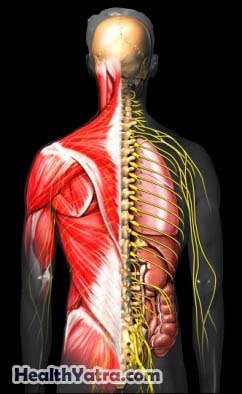সংজ্ঞা
Mitochondrial myopathies are a group of diseases. Each disease has different symptoms. Some may be mild while other are life-threatening. However, the diseases are all caused by a problem with the mitochondria.
Mitochondria are tiny structures found in almost all cells. It is their job to provide energy to these cells. Mitochondrial myopathies can interfere with many different bodily functions. It tends to have the greatest impact on structures that are very active such as the muscles and nerves.

কারণসমূহ
This condition is caused by a mutation in a specific gene.
ঝুঁকির কারণ
Having a family member with the mutated gene increases the risk of mitochondrial myopathies.
লক্ষণ
Mitochondrial myopathies can cause a range of symptoms. Symptoms by specific condition include:
| NAME OF CONDITION | AGE OF ONSET | DEFINING SYMPTOMS |
| Kearns-Sayre syndrome (KSS) | Before age 20 | Salt and pepper pigmentation in eye, eye movement problems (PEO), heart and skeletal muscle dysfunction |
| Leigh’s syndrome | Infancy (can appear later) | Brain abnormalities that lead to muscle problems, seizures, uncoordinated muscle movement (ataxia), impaired vision and hearing, developmental delay and poor control over breathing |
| Mitochondrial DNA depletion syndrome | Infancy | Muscle weakness and liver failure, floppiness, feeding difficulties, and developmental delay |
| Mitochondrial encephalomyopathy, lactic acidosis and stroke-like episodes (MELAS) | Childhood to adulthood | Stroke-like episodes, migraine headaches, vomiting and seizures, muscle weakness, exercise intolerance, hearing loss, diabetes, short stature |
| Myoclonic epilepsy associated with ragged red fibers (MERRF) | Late childhood to adulthood | Myoclonus (jerky movements), seizures, muscle weakness, uncoordinated muscle movement (ataxia) |
| Mitochondrial neurogastrointestinal encephalomyopathy (MNGIE) | Before age 20 | Eye movement problems (PEO), drooping eyelid, limb weakness, digestive problems, peripheral neuropathy |
| Neuropathy, ataxia, and retinitis pigmentosa (NARP) | Early childhood to adulthood | Uncoordinated muscle movement (ataxia), degeneration of the retina in the eye leading to loss of vision |
| Pearson’s syndrome | Infancy | Causes severe anemia and pancreas problems, survivors usually develop KSS |
| Progressive external ophthalmoplegia (PEO) | Adulthood | Eye movement difficulty, and often symptoms of other mitochondrial diseases, but can be an independent syndrome |
Other general symptoms include:
- Muscle weakness or exercise intolerance
- Lack of balance or coordination
- Arryhthmias of the heart or heart failure
- Problems with eye movements—either problems with control or inability to move them
- খিঁচুনি
- Stroke-like episodes
- বমি
- ডিমেনশিয়া
রোগ নির্ণয়
Your doctor will ask about your symptoms and medical history. A physical exam will be done. You will also be asked about any family history of the disease.
পরীক্ষায় নিম্নলিখিতগুলি অন্তর্ভুক্ত থাকতে পারে:
- Muscle biopsy—to look for abnormal levels of mitochondria
- Blood test—to look for abnormal levels of certain enzymes and other substances
- Lumbar puncture (spinal tap) —to evaluate the fluid surrounding the brain and spinal cord
- Electromyography (EMG) and nerve conduction velocity (NCV)—to test nerve and muscle interaction
- Genetic test
- চোখের পরীক্ষা
চিকিৎসা
There is no specific treatment for these diseases. Instead, treatment will focus on managing the symptoms. Treatment options include the following:
খাদ্যতালিকাগত কাজী নজরুল ইসলাম
Supplements may help make energy in the cells. These may include:
- Creatine
- Carnitine
- Coenzyme Q10
Work with your doctor on the doses of these supplements.
শারীরিক চিকিৎসা
Therapy may be used to strengthen muscles and improve mobility. Some may need devices like braces, walkers , or wheelchairs to help them get around.
Speech Therapy
Muscle weakness in the throat may make talking or swallowing difficult. Speech therapy may help strengthen the muscles or work around the weakness.
শ্বাসযন্ত্রের থেরাপি
Respiratory therapy will help make sure you are breathing properly. It may involve some training techniques for respiratory muscles. It can include pressurized air treatment or the use of a ventilator.
ওষুধ
Medicines may be needed for symptoms such as seizures or pain.
প্রতিরোধ
There are no known guidelines to prevent this condition.
